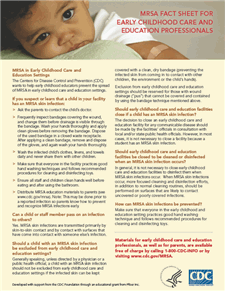Information and Advice about MRSA for School and Daycare Officials
5 Steps to Take if You Think a Student Might Have a Skin Infection
The decision to close a school for any communicable disease should be made by school officials in consultation with local and/or state public health officials. However, in most cases, it is not necessary to close schools because of an MRSA infection in a student. It is important to note that MRSA transmission can be prevented by simple measures such as hand hygiene and covering infections.
Closing to Clean or Disinfect
In general, it is not necessary to close entire schools to “disinfect” them when MRSA infections occur. MRSA skin infections are transmitted primarily by skin-to-skin contact and by contact with surfaces that have come into contact with someone else’s infection. Covering infections will greatly reduce the risks of surfaces becoming contaminated with MRSA.
Refer to the Environmental Cleaning and Disinfecting for MRSA page for more information.
Notifications
School Notifications to the School Community following an MRSA Infection
Staphylococcus (staph) bacteria, including MRSA, have been and remain a common cause of skin infections. Usually, it should not be necessary to inform the entire school community about a single MRSA infection. When an MRSA infection occurs within the school population, the school clinician should determine, based on medical judgment, whether some or all students, parents, and staff should be notified. If medical personnel are not available at the school, consultation with the local public health authorities should be used to guide this decision. Repeat cases, spread to other students, or complex cases should be reported to the health department for consultation.
Notifications to the School that a Student has an MRSA Infection
Most schools require that any communicable disease be reported to the student’s teacher or administration. Consult with your school about its policy.
Excluding Students with MRSA Infections from School
- Unless directed by a physician, students with MRSA infections should not be excluded from attending school.
- Exclusion from school and sports activities should be reserved for those with wound drainage (“pus”) that cannot be covered and contained with a clean, dry bandage and for those who cannot maintain good personal hygiene.
- Read more on the Advice for Coaches and Athletic Directors page.
Practical Advice for Teachers
- If you observe children with open draining wounds or infections, refer the child to the school nurse. If a nurse is not available, call the child’s guardian and refer them to seek medical attention.
- Enforce hand hygiene with soap and water or alcohol-based hand sanitizers (if available) before eating and after using the bathroom.
Advice for School Health Personnel
- Students with skin infections may need to be referred to a licensed health care provider for diagnosis and treatment. School health personnel should notify parents/guardians when possible skin infections are detected.
- Use standard precautions (e.g., hand hygiene before and after contact, wearing gloves) when caring for nonintact skin or potential infections.
- Use barriers such as gowns, masks, and eye protection if splashing of body fluids is anticipated.
Educate Parents and Students
Refer parents and students to the following resources on this site:
Additional Resources
- Page last reviewed: February 3, 2016
- Page last updated: April 7, 2017
- Content source:


 ShareCompartir
ShareCompartir
 Size: 8.5″ X 11″ 1 page brochure
Size: 8.5″ X 11″ 1 page brochure